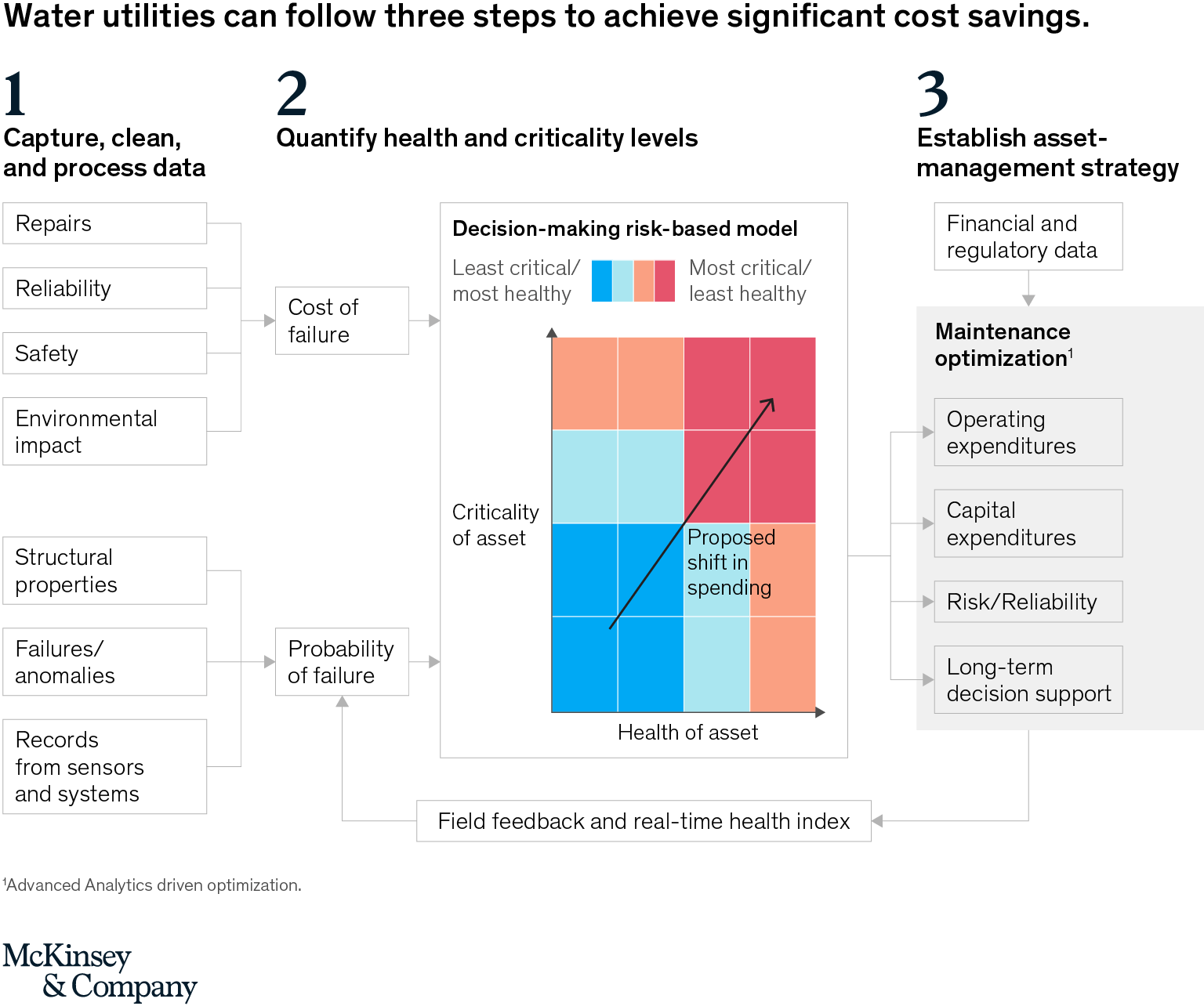Like many utilities, water utilities around the world are facing increased scrutiny of their overall cost profiles. At the same time, they are up against aging infrastructure, increasing nonrevenue losses, and a declining ability to ensure proper supply and sanitation. There’s an urgent need to cut costs—and a clear opportunity to streamline maintenance in operations.
Learning from the power sector, some water utilities are applying new techniques in advanced analytics to help them better understand their assets’ history, health, and criticality. These insights are allowing them to create an asset-management strategy built around predictive maintenance and target the most important and most in-need assets.
Although unfamiliar given many water utilities’ engineering knowledge, harnessing analytics is more straightforward—and beneficial—than companies might expect. Indeed, companies can see benefits using very little data—structural information and failure history, such as corrective work orders, is all that is required to build predictive models for water assets. And while many executives at utilities believe they won’t see benefits for the first few years, a new maintenance plan will immediately result in savings in two areas: savings from being able to focus on the highest risk and most critical assets and savings from decreasing nonrevenue water losses. Finally, such techniques are incredibly accurate at predicting anomalies in pumps and pipes and typically prove to be more than 50 percent more effective than the traditional engineering models used by most of the industry.
How can a company get started? A three-step approach can put water utilities on the path to cost savings (exhibit).

1. Build a data lake
Maintenance and planning engineers can begin by capturing, cleaning, and processing (also known as harmonizing) information about each of their assets—such as OEM, age of installation, and last repair—to build a harmonized data lake in the cloud. While it’s true that utilities can see benefits with very little data, collecting it can be a challenge given that, when data is scarce, it is often patchy, siloed, and not digitized. For example, one water utility worked across departments (water generation, water distribution, and waste-water collection) to compile its data, combining customer-relationship management, geographic-information systems, and maintenance pulls, as well as institutional engineering knowledge, to arrive at a common understanding of its assets.
Once the data lake is established and the data is structured—formatted and categorized consistently—and ready for use in algorithms, intelligent asset management becomes very possible.
2. Quantify asset health and criticality
Next, data scientists should quantify the health and criticality of each asset, using an advanced analytics model to determine assets’ risk value. To quantify an asset’s health, scientists can use the model to combine the established data lake with external data (such as temperature and precipitation forecasts and geography and altitude data) to understand overall asset health and probability of failure. Engineers and finance and safety personnel can then work together to assess the cost of repair, safety track record, and impact of failure—for example, water distribution next to a densely populated center would score high—to determine how critical assets are to the network.
3. Establish an asset-management strategy built around predictive maintenance
Finally, once water utilities understand the health and criticality of assets, they can build an asset-management strategy that focuses on the most critical and least healthy assets. Once they understand how frequently assets are monitored and inspected, they can replace routine and scheduled maintenance practices—such as routinely opening a pit in search of potential leaks or routinely replacing pipes—with targeted preventive maintenance based on suggestions from machine-learning models. In fact, these models will continue to learn based on asset performance, helping to predict the condition of assets in the coming years. Thus, maintenance could include installing a pump well ahead of the recommended timeline or replacing a pipe given its likelihood of failure.
***
Using advanced analytics models to enable predictive maintenance allows water utilities to see typical yearly savings of 10 to 20 percent in maintenance operating expenditures and 20 to 30 percent in capital expenditures, making it a gift that keeps on giving—if implemented correctly.
Izaro Arbide is a consultant in McKinsey’s Madrid office, where Fernando Pérez López is a sr. expert and Jesús Rodríguez Gonzalez is a partner; Diego Hernandez Diaz is an associate partner in the Geneva office, and Gaurang Jhunjhunwala is a partner in the Dubai office.


